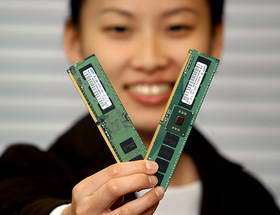Samsung Delivers Next Generation Memory Modules for High Density Data Processing

Samsung Electronics Co., Ltd., the world leader in advanced memory technology, today announced sample production of the next-generation memory module for servers and workstations –a fully buffered, dual in-line memory module (FB DIMM) based on DDR2 technology. The FB DIMM sharply boosts memory density and bandwidth of registered DIMMs to improve data processing.
An Advanced Memory Buffer (AMB) chip has been added to each memory module to enable the use of high- and low-speed interfaces. The buffer can generate speeds from 3.2Gigabits per second (Gbps) to 4.8Gbps. The FB DIMM can attain a maximum speed of 4.8Gbps that is double the speed of a DDR2-400 registered DIMM, when utilizing DDR2-800 components.
Until now, the access rate per channel for memory slots decreased as the memory bus speed increased, limiting density build-up. The FB DIMM eliminates this “stub-bus” channel bottleneck by using point-to-point links that enable up to eight multiple memory modules to be connected serially to a given channel. That will allow a capacity of up to 8GigaByte (GB) per channel or a total of up to 32GBs when incorporating 1GB FB DIMMs.
The new FB DIMM also increases system efficiencies as board design is facilitated due to minimal circuiting. In addition, it prevents errors from occurring in conventional server systems when the number of memory modules exceeds two per channel. With FB DIMMs, servers can increase density levels eight-fold as the DIMM retrieves and stores data in a serial process.
Samsung samples 512MB and 1GB FB DIMMs that comply with existing industry (JEDEC) standards.















